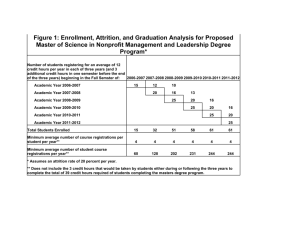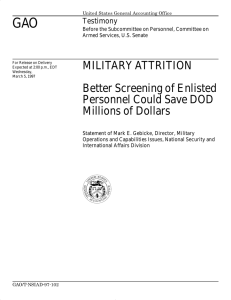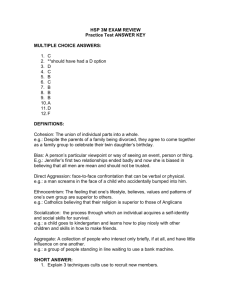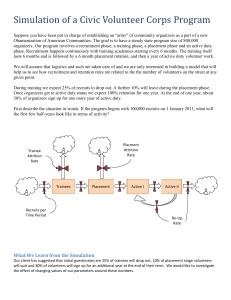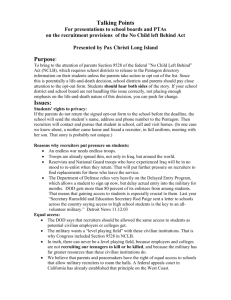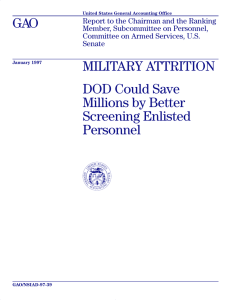GAO MILITARY ATTRITION Better Screening of Enlisted Personnel Could Save
advertisement
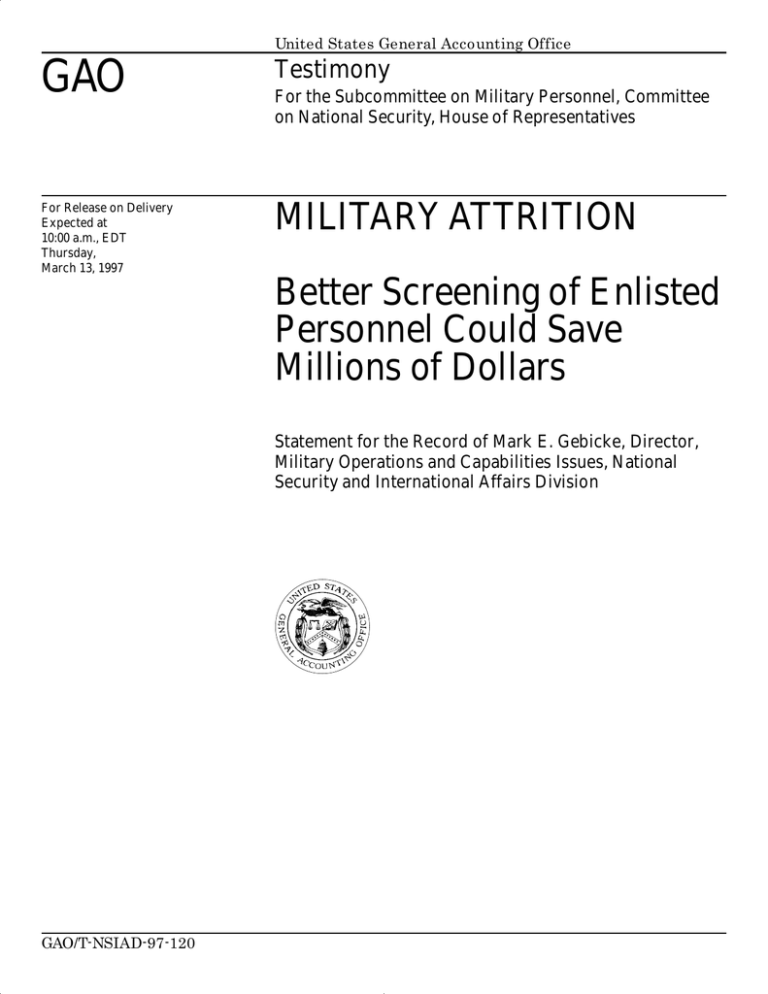
United States General Accounting Office GAO Testimony For Release on Delivery Expected at 10:00 a.m., EDT Thursday, March 13, 1997 MILITARY ATTRITION For the Subcommittee on Military Personnel, Committee on National Security, House of Representatives Better Screening of Enlisted Personnel Could Save Millions of Dollars Statement for the Record of Mark E. Gebicke, Director, Military Operations and Capabilities Issues, National Security and International Affairs Division GAO/T-NSIAD-97-120 Mr. Chairman and Members of the Subcommittee: I am pleased to have been asked to provide a statement for the record on our recently issued report on military enlisted attrition.1 The statement discusses (1) the extent of the attrition problem, (2) the reasons why enlistees are separated, (3) the adequacy of the data the Department of Defense (DOD) has available for setting realistic attrition reduction goals, (4) the savings the services could accrue by achieving their goals for reducing 6-month attrition, and (5) changes in policy since we issued our report in January. Results in Brief In summary, we found that more than 14 percent of new recruits leave the services during the first 6 months, and more than 30 percent leave before the end of their first term. Because of this attrition, the services lose a substantial investment in training, time, equipment, and related expenses and must increase accessions to replace these losses. The main reasons for the high attrition rate during the first 6 months are that (1) the services’ screening of applicants for disqualifying medical conditions or preservice drug use is inadequate and (2) recruits fail to perform adequately because they are in poor physical condition for basic training or lack motivation. Although the services are greatly concerned about attrition, their goals for reducing attrition are based on inconsistent, incomplete data and are unrealistic. If the services were to actually reach their goals, however, they would realize immediate short-term annual savings ranging from $5 million to $39 million. Background The applicants’ first contact with the military is with a service recruiter who prescreens them for disqualifying conditions. The applicants are then sent to military entrance processing stations (MEPS), which are the responsibility of the Military Entrance Processing Command. When the applicants are determined to be qualified, through medical and aptitudinal tests, they are sworn into the Individual Ready Reserve, in an unpaid status, for up to 1 year. Once they are called to active duty, enlisted personnel enter basic training, which can last from 6 to 12 weeks, depending on the service. After basic training, recruits go on to initial skill training, which can range from a few weeks to more than 1 year. (App. I displays the process for recruiting and training enlisted personnel.) 1 Military Attrition: DOD Could Save Millions by Better Screening Enlisted Personnel (GAO/NSIAD-97-39, Jan. 6, 1997). Page 1 GAO/T-NSIAD-97-120 It costs the services between $9,400 and $13,500 in fixed and variable costs to recruit and train an active duty enlistee through basic training. Considering that DOD recruited more than 176,000 new recruits in fiscal year 1994, we calculated that DOD invested more than $2 billion in the recruiting and training of these new personnel. A Significant Amount of Attrition Occurs Within the First 6 Months New recruits take an enlistment oath and sign a contract to serve in one of the military services for a specified period of time, typically 4 years. Despite this contractual obligation, DOD data shows that about one out of every three new recruits fails to complete the first term. Over the past 10 years, this attrition rate has remained about the same in each of the services. We found that a significant portion of first-term attrition occurs during enlistees’ first 6 months in the service. In fiscal year 1994, 6-month attrition rates were 15.7 percent for the Army, 15.7 percent for the Navy, 12.5 percent for the Marine Corps, and 11.6 percent for the Air Force.2 (See table 1.) This means that in fiscal year 1994, more than 25,000 new recruits did not remain in the military beyond the training phase. Table 1: Percentage of Enlistees Who Are Separated in the First 6 Months of Their First Terms Fiscal year enlistees entered the services Army Navy Marine Corps Air Force All services 1986 10.4 13.1 15.9 10.7 11.8 1987 9.2 12.7 13.2 10.0 10.8 1988 9.8 14.4 12.6 9.0 11.6 1989 10.0 12.8 13.9 9.4 11.3 1990 10.7 10.1 15.6 10.2 11.1 1991 13.0 10.2 14.1 10.5 11.9 1992 12.8 12.9 12.9 9.2 12.3 1993 15.3 15.8 13.6 11.6 14.6 1994 15.7 15.7 12.5 11.6 14.4 Source: Defense Manpower Data Center. 2 The Defense Manpower Data Center maintains data on all the services’ enlistees; fiscal year 1994 was the most current year for which complete data was available. Page 2 GAO/T-NSIAD-97-120 Screening Processes Do Not Identify Thousands of Recruits Who Are Unqualified for Service About 83 percent of the 25,000 who entered the services in fiscal year 1994 and were separated in their first 6 months were discharged because they (1) were medically unqualified for military service, (2) failed to meet minimum performance criteria, (3) had fraudulently or erroneously entered the military, or (4) had character or behavior disorders. Separations for medical conditions and failure to meet performance standards represent at least 55 percent of all 6-month attrition for enlistees who entered the services in fiscal year 1994. However, this percentage is misleading for two reasons. First, some persons who have medical problems are categorized as fraudulent enlistments because they concealed medical problems. Second, some persons who have performance problems are categorized as having character or behavior disorders. Our review indicated that the DOD screening processes were not working and there were insufficient incentives and checks to ensure that the services are recruiting qualified personnel. For example, recruiters do not have adequate incentives to ensure that their recruits are fully qualified. In a sense, recruiters have a built-in conflict of interest. Although they are expected to recruit only fully qualified personnel, their performance is judged primarily on the number of recruits they enlist per month. Recruiters’ monthly recruiting goals are established on the basis of the services’ personnel needs, which are in turn driven by end-strength numbers and budget allocations. The recruiters’ goals are also connected to the numbers of slots for basic and follow-on training. That is, recruiters must keep a steady and constant flow of enlisted personnel into the services. We believe that the services do not provide recruiters with adequate incentives to ask applicants probing questions that might reveal disqualifying information. Asking probing questions leads to two complications for recruiters. First, if recruiters uncover potentially disqualifying information about their applicants, they create more paperwork for themselves in that they must request waivers. Second, recruiters might have to reject applicants who are not qualified and miss their monthly goals. In June 1996, the Navy began to subtract points from recruiters’ quotas when their enlistees did not graduate from basic training. While this change appears quite positive, it is too early to determine its effect on attrition. Over the years, the Marine Corps has allowed its recruiting units the flexibility to tie recruiters’ incentive systems to enlistees’ successful Page 3 GAO/T-NSIAD-97-120 completion of basic training. However, this policy has not been uniformly applied throughout the Marine Corps, and its incentive system, like those of the other services, does not appear to provide adequate incentives for recruiters to screen out unqualified applicants. Thousands of Recruits Are Found to Be Not Medically Qualified Another reason that unqualified personnel are entering the services and being separated within their first 6 months is that medical screening, performed by Military Entrance Processing Station physicians, is not comprehensive enough. The medical exams do not detect many problems that later result in early separations. Around 6,800 of the approximately 25,000 enlistees who entered the services in fiscal year 1994 and did not complete their first 6 months of service were found to be not medically qualified. The services are enlisting persons with disqualifying medical conditions for two primary reasons: (1) applicants knowingly and unknowingly conceal their medical histories and (2) the services waive medical conditions that, according to DOD directives, are disqualifying. One reason that applicants might not disclose significant aspects of their medical histories is that the services do not require all applicants to provide the names of their medical insurers or their past medical providers. If applicants report no medical problems, they are not required to provide any supporting documentation. Also, the medical screening forms used to question applicants for their medical histories contain vague and ambiguous questions and may be easy for applicants to misunderstand or falsify. Another inadequacy of DOD’s medical screening process is that DOD does not have a system for determining which medical conditions represent good attrition risks. At present, DOD’s physical enlistment standards are not empirically linked to performance in the military, but rather are based on military experience and judgment. Also, the services now waive many of these physical enlistment standards. The Army, for example, told us that the only two medical conditions for which waivers cannot be granted are pregnancy that existed prior to enlistment and human immunodeficiency virus. In September 1996, DOD funded a project to compile a comprehensive database of medical conditions for all military personnel. This database will enable DOD to reevaluate its physical enlistment standards, analyze the medical reasons that recruits are separated, make fact-based policy changes to reduce medical attrition, and determine the cost-effectiveness of providing more medical tests to all or selected groups of applicants. Page 4 GAO/T-NSIAD-97-120 We also found that as a result of the services’ varying drug-testing policies, more Navy and Marine Corps enlisted personnel were separated during basic training than was the case with the Army and the Air Force. This was because the Air Force and the Army tested all of their applicants for drugs at the MEPS, before they enlisted, while—at the time of our review—the Navy and the Marine Corps tested their applicants at basic training, after they had enlisted. In fiscal year 1994, 1,669 recruits were discharged from the Navy because of drug use. The Navy offered no waivers for positive drug tests. On the other hand, in fiscal years 1995 and 1996, around 70 percent of recruits who tested positive for marijuana at Parris Island Marine Corps Recruit Depot were granted waivers. In fiscal year 1995, 332 recruits tested positive for marijuana at Parris Island; 231 of these received waivers. By May of fiscal year 1996, 280 recruits had tested positive for marijuana at Parris Island, and 194 of these received waivers. Thousands of Recruits Are Discharged for Failure to Meet Minimum Performance Criteria More than 7,200 of the recruits who entered the services in fiscal year 1994 were discharged in the first 6 months of service because they failed to meet minimum performance criteria. Basic training personnel throughout the services told us that these recruits are not physically prepared for basic training and lack motivation. Basic training personnel suggested that recruits might be better prepared for the physical demands of basic training if they were more fully informed of the services’ physical training requirements and encouraged to become physically fit before going to basic training. All the services now encourage their applicants to undergo physical training while they await the call to active duty. However, we believe that the services could provide further incentives for applicants to get into good physical shape. For example, the services could ensure that applicants have access to military fitness centers and to military medical treatment facilities if they are injured. To improve recruits’ motivation during training, all the services have taken actions to improve the basic training environment. They have established special units for recruits with motivational problems and injuries. Despite these efforts, our interviews with 126 separating recruits suggest that negative leadership techniques continue to be a factor in recruits’ lack of motivation to meet performance standards. While all four services have similar prohibitions on drill instructors’ treatment of basic trainees, about Page 5 GAO/T-NSIAD-97-120 one-third of the separating recruits we interviewed told us that they were subjected to “humiliating” treatment and that this treatment contributed to their desire to leave the military. We were told that drill instructors frequently used obscene language, although such language is prohibited by service regulations. Although we cannot generalize from our interviews, what we heard from recruits reinforced Army, Air Force, and Rand studies, which concluded that negative motivation has a detrimental effect on some recruits’ desire to stay in the military. DOD’s Data Does Not Allow the Services to Set Realistic Attrition Goals While significant savings could be achieved by reducing attrition, we believe that the services’ current goals for reducing attrition are arbitrary. That is, DOD and the services do not currently have sufficient information to determine what portion of 6-month attrition is truly avoidable. The danger of setting arbitrary attrition-reduction goals is that the services could simply begin to retain lower quality recruits, whom they are currently separating, in order to meet the goals. To set realistic and achievable targets for reducing attrition, DOD and the services need more complete and accurate data on why recruits are being separated. DOD’s current data on attrition is inconsistent and incomplete for two reasons. First, the services interpret DOD’s definitions of separation codes differently and therefore place enlistees with identical situations in different discharge categories. For example, an enlisted person who cannot adapt to military life is separated from the Air Force for a personality disorder, from the Navy for an erroneous enlistment, and from the Army and the Marine Corps for failure to meet minimum performance standards. Second, DOD’s separation codes—which represent DOD’s primary source of service-wide data on why people are leaving the services—capture only the official reason for discharge. Our analysis of these separation codes and our interviews with service officials and separating recruits revealed that enlistees generally have many reasons for leaving, only one of which is recorded in DOD’s database on separations. In an attempt to standardize the services’ use of these codes, DOD issued a list of the codes with their definitions. However, it has not issued implementing guidance for interpreting these definitions. Page 6 GAO/T-NSIAD-97-120 DOD Could Save Millions of Dollars by Reducing Attrition All the services agree that reducing early attrition is desirable. To this end, three services have developed attrition-reduction goals ranging from 4 to 10 percent. We estimate that if the services were to reduce their 6-month attrition by 4 percent, their immediate short-term savings would be $4.8 million per year.3 If the services achieved a 10-percent reduction of attrition, their short-term savings would be $12 million. In other words, if the services could screen out 10 percent of those unqualified applicants who are now being sent to basic training, they could realize immediate savings of $12 million each year. Although the services’ goals are arbitrary, they clearly illustrate that the services could realize immediate, short-term savings because they would be transporting, feeding, clothing, and paying fewer recruits. In some cases, reducing attrition may require that the services add pre-enlistment medical tests or more screening mechanisms to their recruiting and examining processes. However, we believe, and the Congressional Budget Office agrees, that these added costs would be more than offset by the immediate short-term savings. Even larger dollar savings could be realized over time as the services began to reduce the infrastructure associated with recruiting and training enlistees. We derived our estimates by determining the marginal cost of sending a Navy recruit to basic training and then separating him or her. We assumed this cost would be similar for all the services.4 For example, the Navy calculates that its marginal cost for each recruit who is separated from basic training is $4,700 for each male and $4,900 for each female. These figures are based on the Navy’s estimate that it costs $83 to transport a recruit to basic training; $3,650 to pay, feed, and house the recruit while at basic training;5 $91 to provide the recruit’s medical examination at basic training; $817 to provide a male recruit with clothing ($995 for a female recruit); and an additional $83 to transport the recruit home after separation. 3 The Congressional Budget Office (CBO) has agreed with our estimate of about $5 million in annual short-term savings that would result from the services’ 4-percent reduction of attrition. CBO calculates that if the services reduced the attrition that results from inadequate medical screenings designed to identify pre-existing conditions, DOD could save $5 million in fiscal year 1998, $5 million in fiscal year 1999, $5 million in fiscal year 2000, $6 million in fiscal year 2001, and $6 million in fiscal year 2002. CBO’s estimates include a calculation of the offsetting costs of adding new medical screening tests. 4 We requested similar cost data from the other three services. They were unable, however, to provide us with marginal costs comparable to those of the Navy because the services (1) calculated costs differently, (2) captured different data elements, and (3) did not capture certain data elements that are necessary to calculate how much it costs to send recruits to basic training and then separate them. 5 This calculation is based on the Navy’s estimate that the average recruit remains at basic training 25 days before being separated and costs the Navy $146 per day. Page 7 GAO/T-NSIAD-97-120 Over time, the services could save even more money by gradually reducing the infrastructure associated with recruiting and training its enlisted personnel. We estimate that in fiscal year 1996, DOD and the services spent about $390 million in fixed and variable costs to recruit and train individuals who never made it to their first duty stations. This cost includes both the marginal costs discussed earlier and the cost of maintaining DOD’s recruiting and training infrastructures. According to DOD, it costs between $9,400 and $13,500 to recruit and train an active duty enlistee through basic training and an additional $6,100 to $16,300 to train the enlistee in an initial skill. Over time, if the services reduced 6-month attrition by 4 percent, their marginal and fixed-cost savings could be as high as $15.6 million. If they were able to reduce their 6-month attrition by 10 percent, potential savings for both marginal and fixed costs could be as much as $39 million. Service Actions in Response to the Recommendations in Our January 1997 Report In our January 1997 report, we made several recommendations to reduce the attrition of enlisted personnel during the first 6 months of their terms of enlistment. Among them, we recommended that the Secretary of Defense issue implementing guidance on DOD’s separation codes and direct the services to strengthen their recruiter incentive and medical screening systems. We also recommended that DOD use its newly proposed database of medical diagnostic codes to improve medical screening and move all the services’ drug testing to the MEPS. The services have taken some action since we issued our report. Although it is too soon for us to draw any sound conclusions, we are intrigued by three initiatives that the Navy says it is undertaking to (1) strengthen the relationship between its recruiting and training activities, (2) more accurately define recruit quality, and (3) change its drug-testing policy. Officials within the Navy’s Recruiting Command told us that they are already subtracting a percentage of the incentive points from their recruiters when their enlistees fail to graduate from recruit training and adding a smaller number of incentive points to their recruiters’ records when their enlistees graduate. These officials also told us that they are seriously considering making more stringent modifications to this policy. According to these officials, a Recruiting Command working group has proposed deducting total incentive points from a recruiter for all recruits, regardless of reason, who separate within the first 30 days of recruit training. We believe this change, which was scheduled to take effect this week, follows the intent of the recommendation in our recent report on Page 8 GAO/T-NSIAD-97-120 attrition that the services more closely link their recruiting quotas to their recruits’ successful completion of basic training. According to Navy Recruiting Command officials, the Command is also attempting to use data maintained at the Navy’s Recruit Training Command to identify all the factors that make a quality recruit. Currently, DOD defines a “quality” recruit as one who has a high school degree and has scored in the upper mental categories on the Armed Forces Qualification Test. Despite historically meeting DOD’s benchmarks for quality, all of the services continue to experience early attrition, thus suggesting that certain elements that make a quality recruit are not captured in the current standards. The Navy hopes to gain a better understanding of recruit quality through this initiative. Navy officials tell us that they will soon be testing applicants for drugs at the MEPS, as well as at basic training. They say that, after reviewing the effectiveness of this change in policy, they may later eliminate drug-testing at basic training. Our recent work with the Army and the Air Force indicates that these two services still see clear lines of separation between recruiting and basic training. Officials within these services have expressed concerns that recruiters should not be held accountable for actions that occur beyond their control at basic training and later. The Marine Corps currently does not operate under a national recruiter incentive system, but instead provides its regions, districts, and stations with the flexibility to design their own recruiter incentive systems. The Marine Corps intends to implement a national system in fiscal year 1998. Page 9 GAO/T-NSIAD-97-120 Appendix I Process of Recruiting and Training Enlisted Personnel Source: GAO. (703196) Page 10 GAO/T-NSIAD-97-120 Ordering Information The first copy of each GAO report and testimony is free. Additional copies are $2 each. Orders should be sent to the following address, accompanied by a check or money order made out to the Superintendent of Documents, when necessary. VISA and MasterCard credit cards are accepted, also. Orders for 100 or more copies to be mailed to a single address are discounted 25 percent. Orders by mail: U.S. General Accounting Office P.O. Box 6015 Gaithersburg, MD 20884-6015 or visit: Room 1100 700 4th St. NW (corner of 4th and G Sts. NW) U.S. General Accounting Office Washington, DC Orders may also be placed by calling (202) 512-6000 or by using fax number (301) 258-4066, or TDD (301) 413-0006. Each day, GAO issues a list of newly available reports and testimony. To receive facsimile copies of the daily list or any list from the past 30 days, please call (202) 512-6000 using a touchtone phone. A recorded menu will provide information on how to obtain these lists. For information on how to access GAO reports on the INTERNET, send an e-mail message with "info" in the body to: info@www.gao.gov or visit GAO’s World Wide Web Home Page at: http://www.gao.gov PRINTED ON RECYCLED PAPER United States General Accounting Office Washington, D.C. 20548-0001 Official Business Penalty for Private Use $300 Address Correction Requested Bulk Rate Postage & Fees Paid GAO Permit No. G100

